The Performance of Niobium-Microalloying Ultra-High-Strength Bridge Cable Steel during Hot Rolling
Abstract
:1. Introduction
2. Materials and Methods
3. Experimental Results
3.1. Volume Fraction of Static Recrystallization
3.2. Microstructural Characterization of Static Recrystallization
4. Discussion
4.1. The Impact of Niobium-Microalloying on Static Recrystallization
4.2. Analysis of Thermal Deformation Process Parameters of Bridge Cable Steel
5. Conclusions
- The experimental results clearly demonstrate that Nb-microalloying can effectively inhibit static recrystallization and promote grain refinement. The addition of Nb significantly reduces the volume fraction of static recrystallization, leading to finer grain sizes and higher deformation resistance.
- This study also found that under a deformation temperature of 975 °C, Nb-microalloyed high-carbon steel achieves finer grain sizes than Nb-free steel when held for 10–50 s. However, the rate of grain size growth accelerates after an intermediate dwelling time of over 50 s, related to the increased deformation resistance caused by Nb.
- The optimal hot-rolling conditions for new bridge cable steel are as follows: For Nb-free steel, the finishing temperature in the roughing stage should be ≥1000 °C, and the inter-pass time ≥ 10 s; the starting temperature in the finishing stage should be ≤900 °C, and the inter-pass time ≤ 5 s. For Nb-bearing steel, the finishing temperature in the roughing stage should be ≥1000 °C, and the inter-pass time ≥ 100 s; the starting temperature in the finishing stage should be ≤925 °C, and the inter-pass time ≤ 5 s.
Author Contributions
Funding
Institutional Review Board Statement
Informed Consent Statement
Data Availability Statement
Conflicts of Interest
References
- Ren, L.; Fang, Z.; Wang, K. Design and behavior of super-long span cable-stayed bridge with CFRP cables and UHPC members. Compos. Part B Eng. 2019, 164, 72–81. [Google Scholar] [CrossRef]
- Chehrazi, A.; Liang, W.; Huda, N.; Walbridge, S. Fretting fatigue tests and microstructure analysis of bridge stay cable wires. Fatigue Fract. Eng. Mater. Struct. 2023, 46, 3145–3160. [Google Scholar] [CrossRef]
- Hobbacher, A.F.; Hicks, S.J.; Karpenko, M.; Thole, F.; Uy, B. Transfer of Australasian bridge design to fatigue verification system of Eurocode 3. J. Constr. Steel Res. 2016, 122, 532–542. [Google Scholar] [CrossRef]
- Borchers, C.; Kirchheim, R. Cold-drawn pearlitic steel wires. Prog. Mater. Sci. 2016, 82, 405–444. [Google Scholar] [CrossRef]
- Javaheri, V.; Khodaie, N.; Kaijalainen, A.; Porter, D. Effect of niobium and phase transformation temperature on the microstructure and texture of a novel 0.40% C thermomechanically processed steel. Mater. Charact. 2018, 142, 295–308. [Google Scholar] [CrossRef]
- Zhou, J.; Hu, C.; Hu, F.; Hou, T.; Yin, C.; Zhu, X.; Wu, K. Insight into the effect of Nb microalloying on the microstructure-property relationship of a novel wire rod. J. Mater. Res. Technol. 2021, 16, 276–289. [Google Scholar] [CrossRef]
- Hecht, M.D.; Webler, B.A.; Picard, Y.N. Effects of Nb Modification and Cooling Rate on the Microstructure in an Ultrahigh Carbon Steel. Metall. Mater. Trans. A 2018, 49, 2161–2172. [Google Scholar] [CrossRef]
- Knyazyuk, T.V.; Novoskoltsev, N.S.; Zisman, A.A.; Khlusova, E.I. Influence of Niobium Microalloying on the Kinetics of Static and Dynamic Recrystallization during Hot Rolling of Medium-Carbon High-Strength Steels. Inorg. Mater. Appl. Res. 2020, 11, 1325–1332. [Google Scholar] [CrossRef]
- Rancel, L.; Gómez, M.; Medina, S.F. Influence of Microalloying Elements (Nb, V, Ti) on Yield Strength in Bainitic Steels. Steel Res. Int. 2008, 79, 947–953. [Google Scholar] [CrossRef]
- Wu, H.; Guo, H.; Hu, B.; Enomoto, M.; Shang, C. Ultra-high strength attributed to retardation of recrystallization during intercritical annealing in cold-rolled (V,Nb) microalloyed 5Mn steel. Mater. Sci. Eng. A 2020, 794, 139789. [Google Scholar] [CrossRef]
- Klančnik, G.; Foder, J.; Bradaškja, B.; Kralj, M.; Klančnik, U.; Lalley, P.; Stalheim, D. Hot Deformation Behavior of C-Mn Steel with Incomplete Recrystallization during Roughing Phase with and without Nb Addition. Metals 2022, 12, 1597. [Google Scholar] [CrossRef]
- Ebrahimi, G.; Momeni, A.; Ezatpour, H. Modeling the viscoplastic behavior and grain size in a hot worked Nb-bearing high-Mn steel. Mater. Sci. Eng. A 2018, 714, 25–35. [Google Scholar] [CrossRef]
- Zhu, X.; Zhou, J.; Hu, C.; Wu, K.; Shen, Y.; Zhang, Y.; Jiang, Y. Application Research on Nb Microalloying of High-Carbon Pearlite Bridge Cable Wire Rods. Materials 2023, 16, 2160. [Google Scholar] [CrossRef]
- Song, L.; Appel, F.; Wang, L.; Oehring, M.; Hu, X.; Stark, A.; He, J.; Lorenz, U.; Zhang, T.; Lin, J.; et al. New insights into high-temperature deformation and phase transformation mechanisms of lamellar structures in high Nb-containing TiAl alloys. Acta Mater. 2020, 186, 575–586. [Google Scholar] [CrossRef]
- Monschein, S.; Ragger, K.S.; Zügner, D.; Fasching, J.; Schnitzer, R. Influence of the Ti Content on the Grain Stability and the Recrystallization Behavior of Nb-Alloyed High-Strength Low-Alloyed Steels. Steel Res. Int. 2022, 93, 2200094. [Google Scholar] [CrossRef]
- Dey, I.; Ghosh, S.K.; Saha, R. Effects of cooling rate and strain rate on phase transformation, microstructure and mechanical behaviour of thermomechanically processed pearlitic steel. J. Mater. Res. Technol. 2019, 8, 2685–2698. [Google Scholar] [CrossRef]
- Mohebbi, M.S.; Parsa, M.H.; Rezayat, M.; Orovčík, L.u. Analysis of flow behavior of an Nb-Ti microalloyed steel during hot deformation. Metall. Mater. Trans. A 2018, 49, 1604–1614. [Google Scholar] [CrossRef]
- AM, E.; Wanjara, P.; Yue, S. Metadynamic and static recrystallization of hypereutectoid steel. ISIJ Int. 2003, 43, 1080–1088. [Google Scholar]
- Miura, H.; Kobayashi, M.; Watanabe, C.; Sugiura, N.; Yoshinaga, N. Static Recrystallization Behavior and Mechanical Properties of Heterogeneous Nanostructured Duplex Phase Stainless Steel. Mater. Trans. 2020, 61, 416–419. [Google Scholar] [CrossRef]
- Liu, X.; Li, T.; Zhao, C.; Wang, Y. Effect of Nb, Ti microalloying on hot deformation behavior of high strength steel. AIP Adv. 2023, 13, 075317. [Google Scholar] [CrossRef]
- Zhao, Y.; Zheng, J.; Chen, L.; Liu, X. Static Recrystallization Behavior of Low-Carbon Nb-V-Microalloyed Forging Steel. Metals 2022, 12, 1745. [Google Scholar] [CrossRef]
- Jones, A.R.; Howell, P.R.; Ralph, B. The precipitation of niobium carbide at grain boundaries in an austenitic stainless steel. J. Mater. Sci. 1976, 11, 1593–1599. [Google Scholar] [CrossRef]
- Konat, Ł.; Zemlik, M.; Jasiński, R.; Grygier, D. Austenite Grain Growth Analysis in a Welded Joint of High-Strength Martensitic Abrasion-Resistant Steel Hardox 450. Materials 2021, 14, 2850. [Google Scholar] [CrossRef]
- Ezatpour, H.R.; Torabi-Parizi, M.; Ebrahimi, G.R.; Momeni, A. Effect of Micro-Alloy Elements on Dynamic Recrystallization Behavior of a High-Manganese Steel. Steel Res. Int. 2018, 89, 1700559. [Google Scholar] [CrossRef]
- Niewczas, S.; Sitko, M.; Madej, Ł. Influence of the Grain Boundary Curvature Model on Cellular Automata Static Recrystallization Simulations. Key Eng. Mater. 2022, 926, 1977–1985. [Google Scholar] [CrossRef]
- Tavakoli, M.; Mirzadeh, H.; Zamani, M. Static recrystallization kinetics of ferrite in cold-deformed medium carbon steel. Mater. Res. Express 2020, 6, 1265–1269. [Google Scholar] [CrossRef]
- Tavakoli, M.; Mirzadeh, H.; Zamani, M. Ferrite recrystallisation and intercritical annealing of cold-rolled low alloy medium carbon steel. Mater. Sci. Technol. 2019, 35, 1932–1941. [Google Scholar] [CrossRef]
- Buken, H.; Kozeschnik, E. Modeling Static Recrystallization in Al-Mg Alloys. Metall. Mater. Trans. A 2021, 52, 544–552. [Google Scholar] [CrossRef]
- Qiao, S.-b.; He, X.-k.; Xie, C.-s.; Liu, Z.-d. Static recrystallization behavior of SA508Gr.4N reactor pressure vessel steel during hot compressive deformation. J. Iron Steel Res. Int. 2021, 28, 604–612. [Google Scholar] [CrossRef]
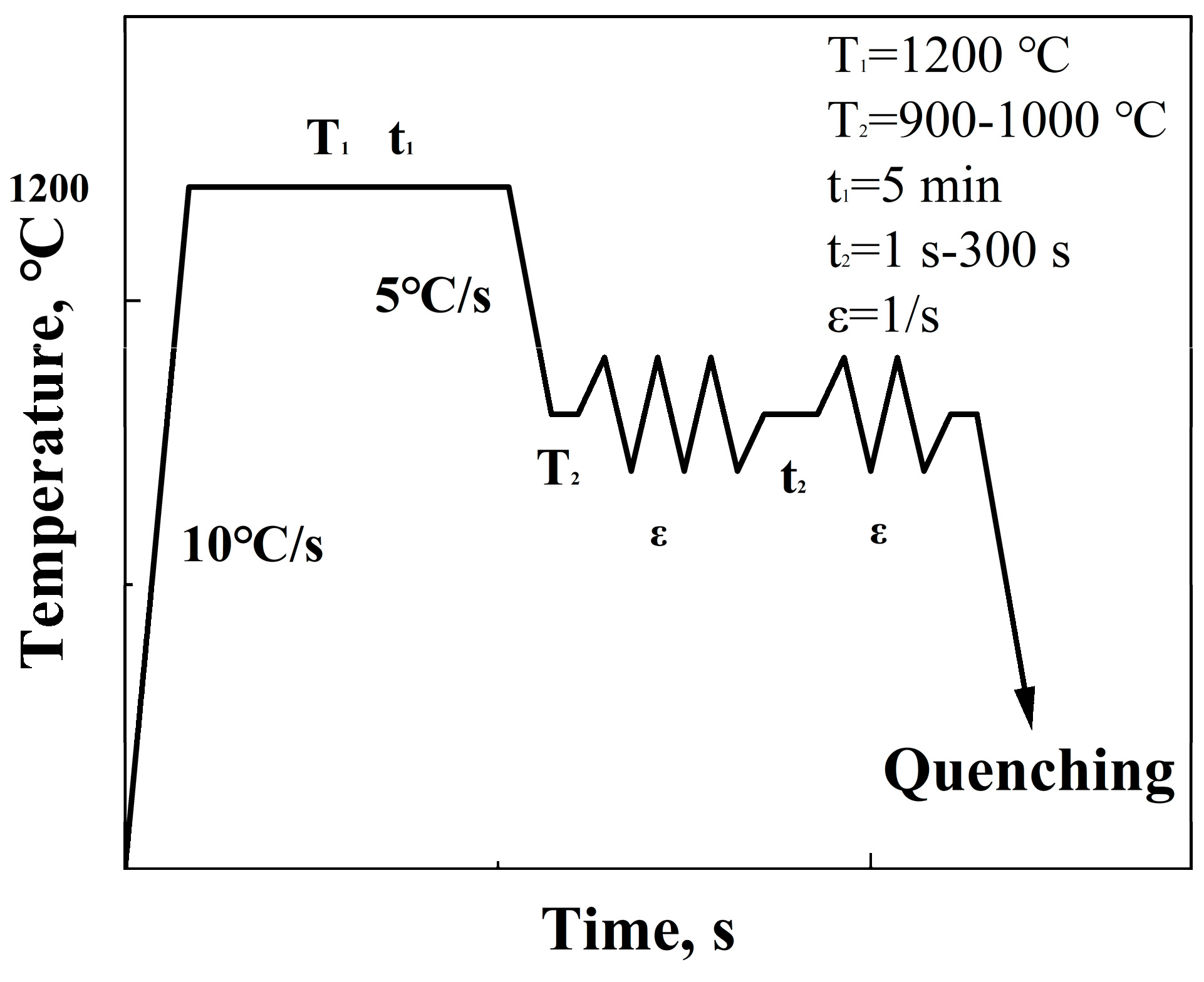
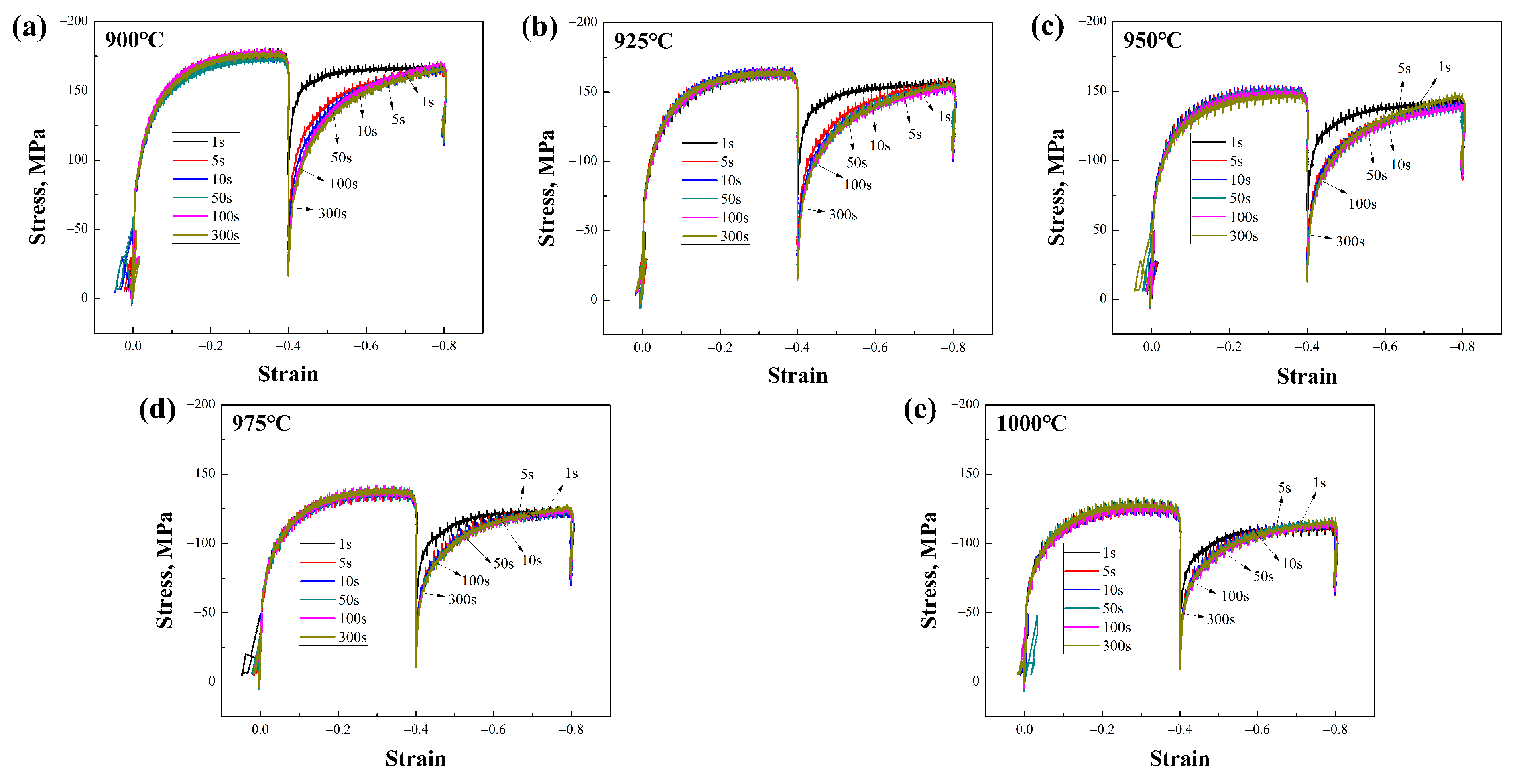
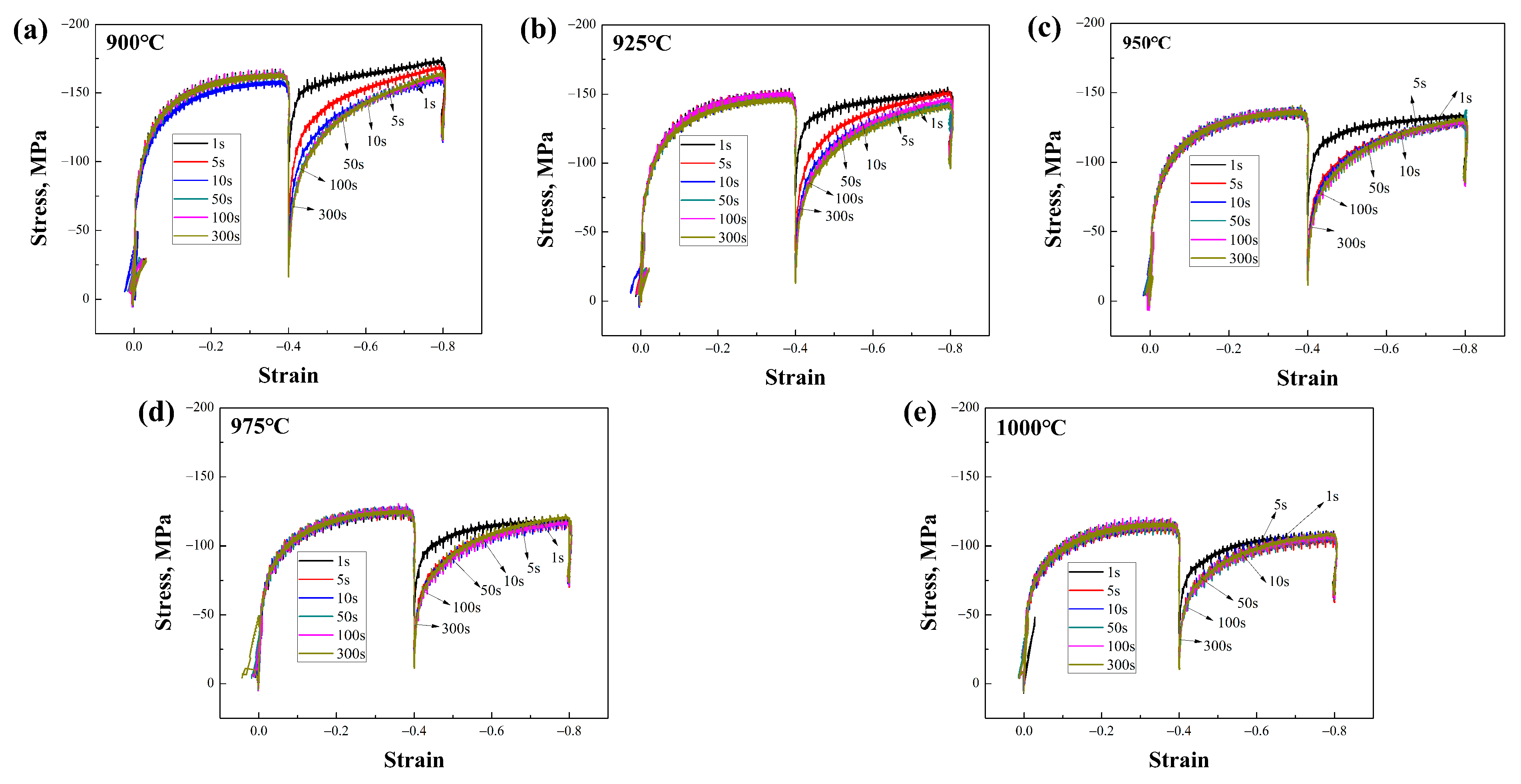
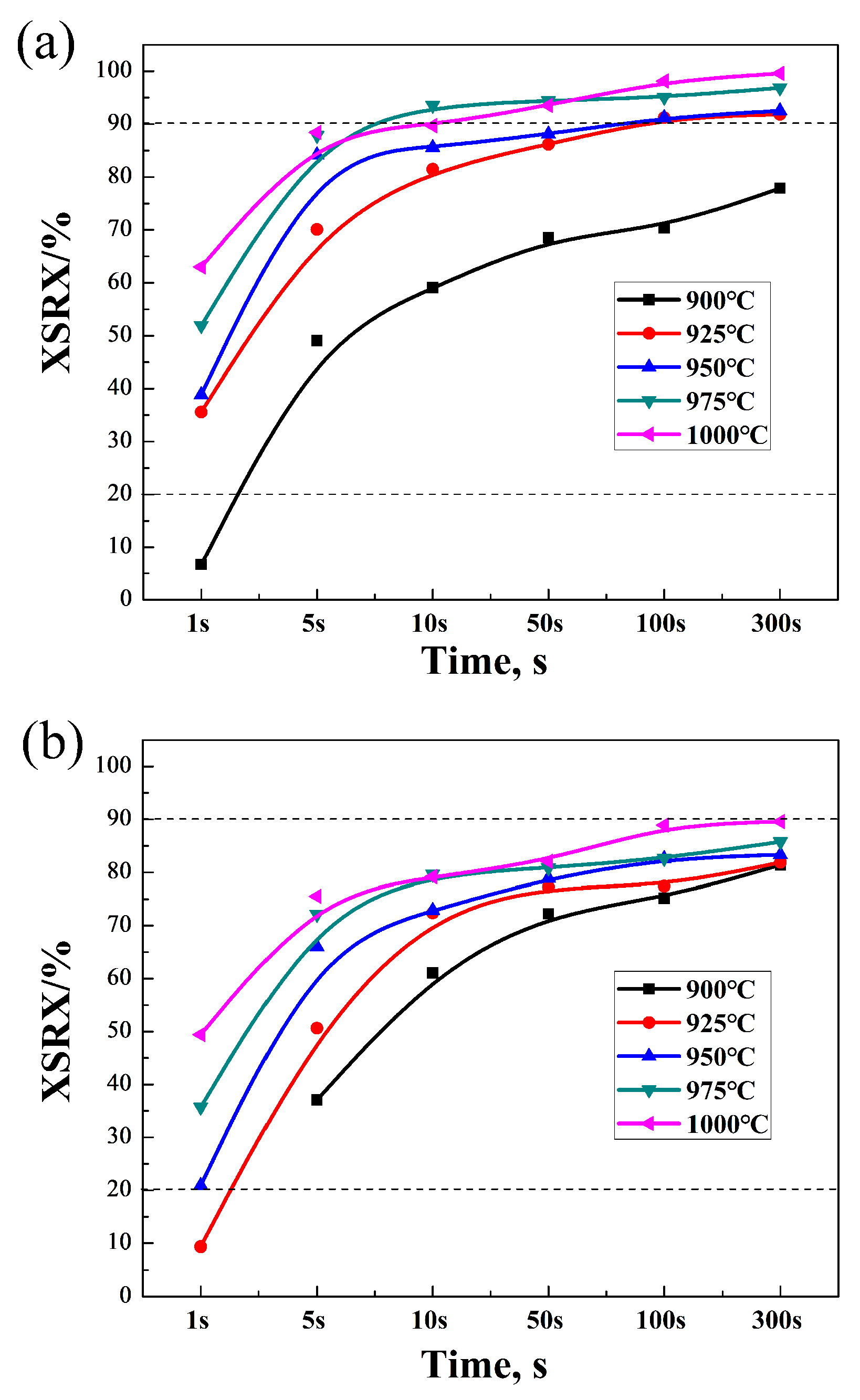
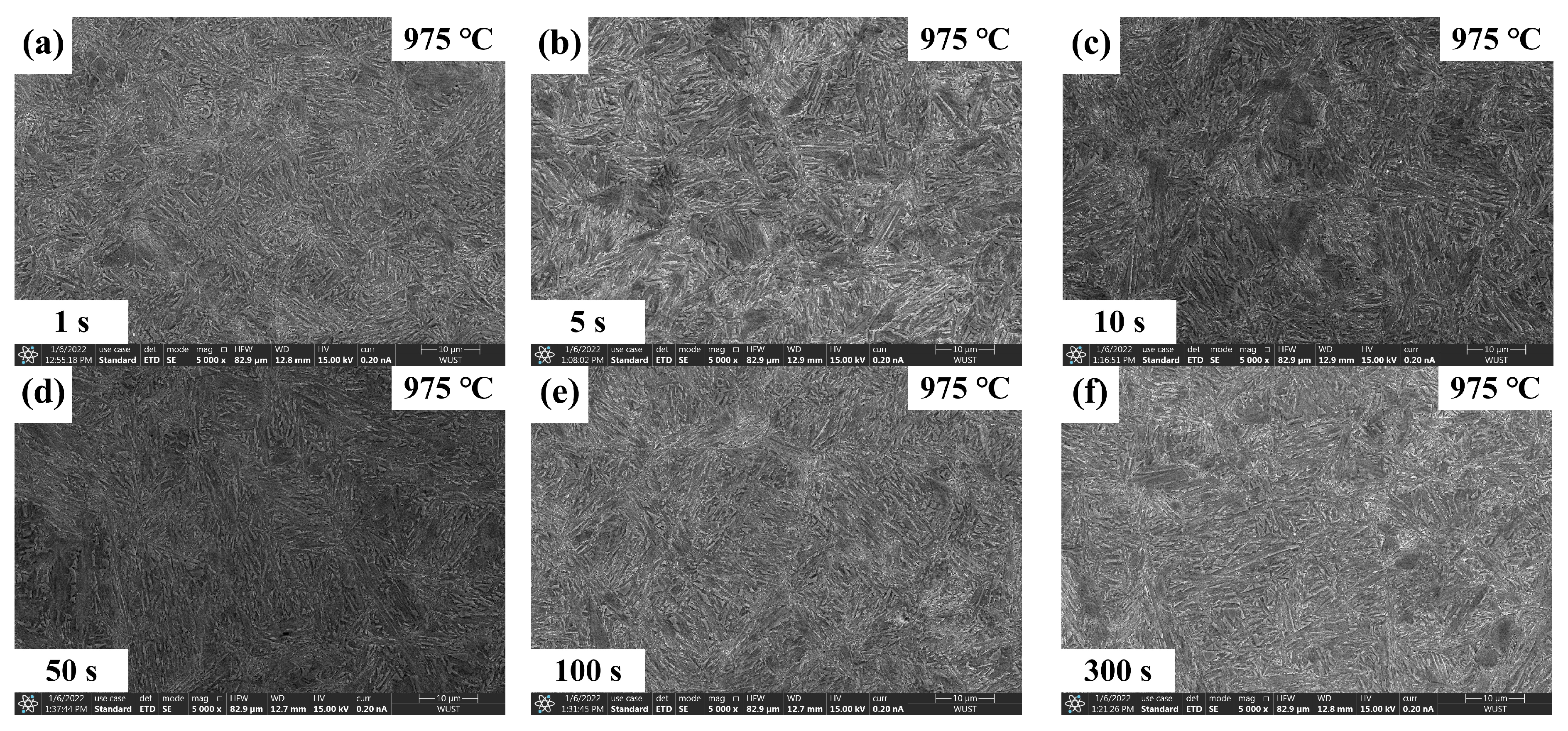
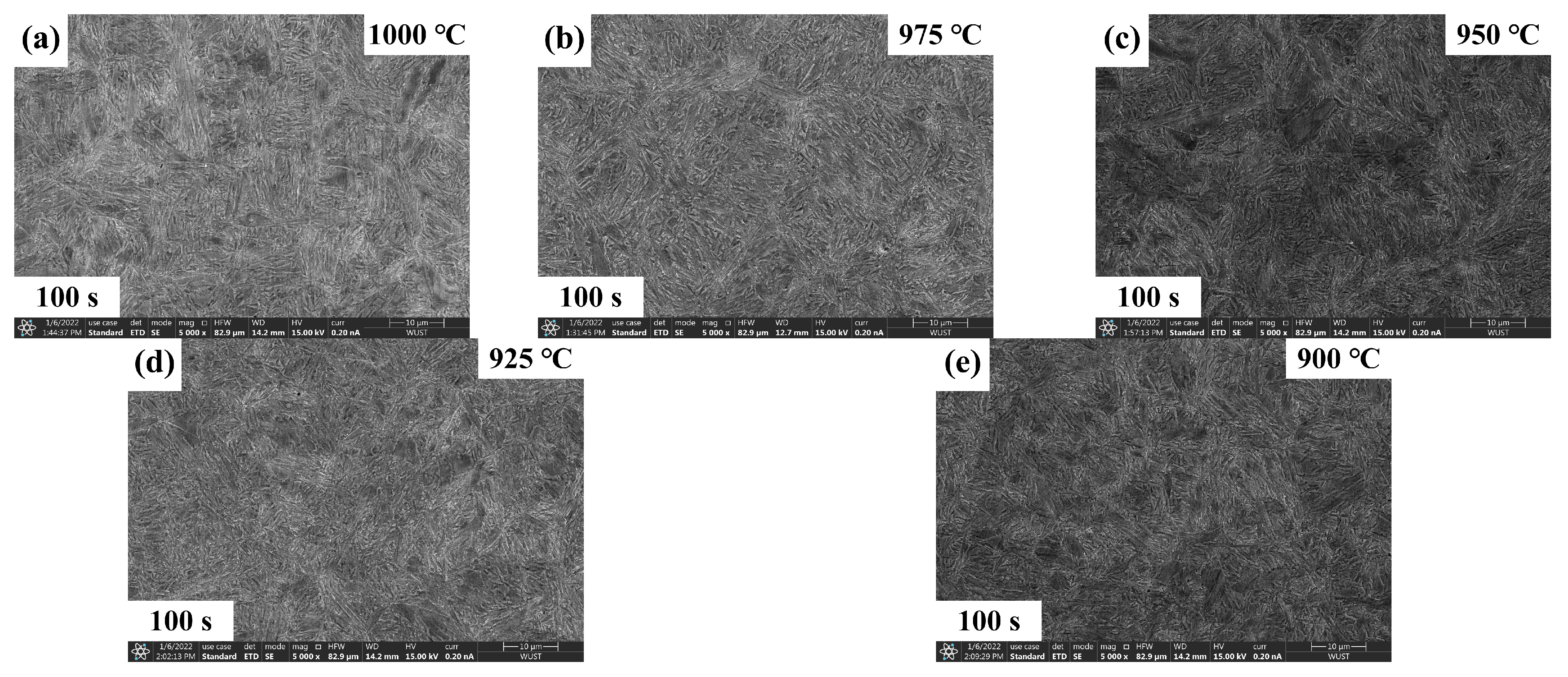
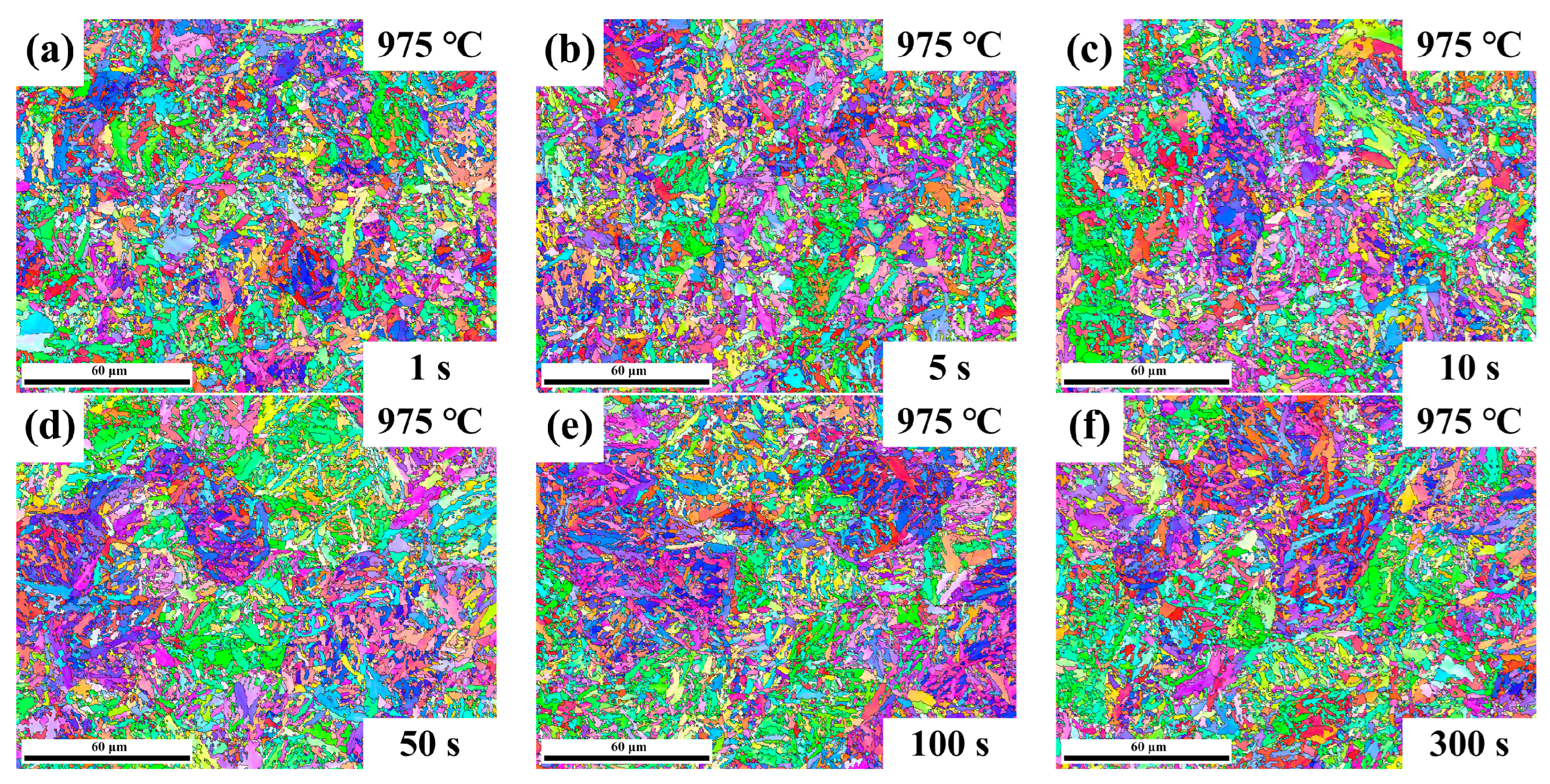
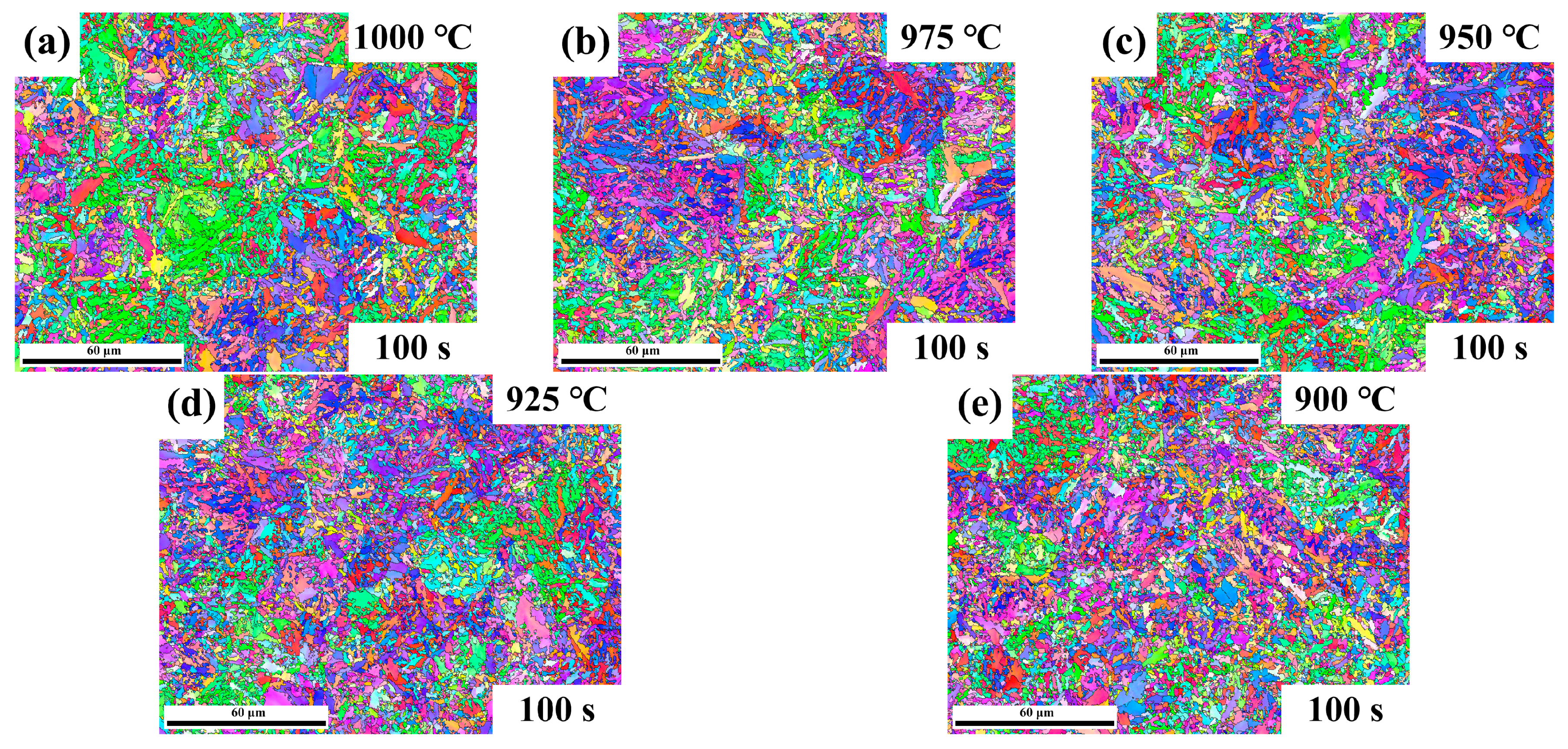
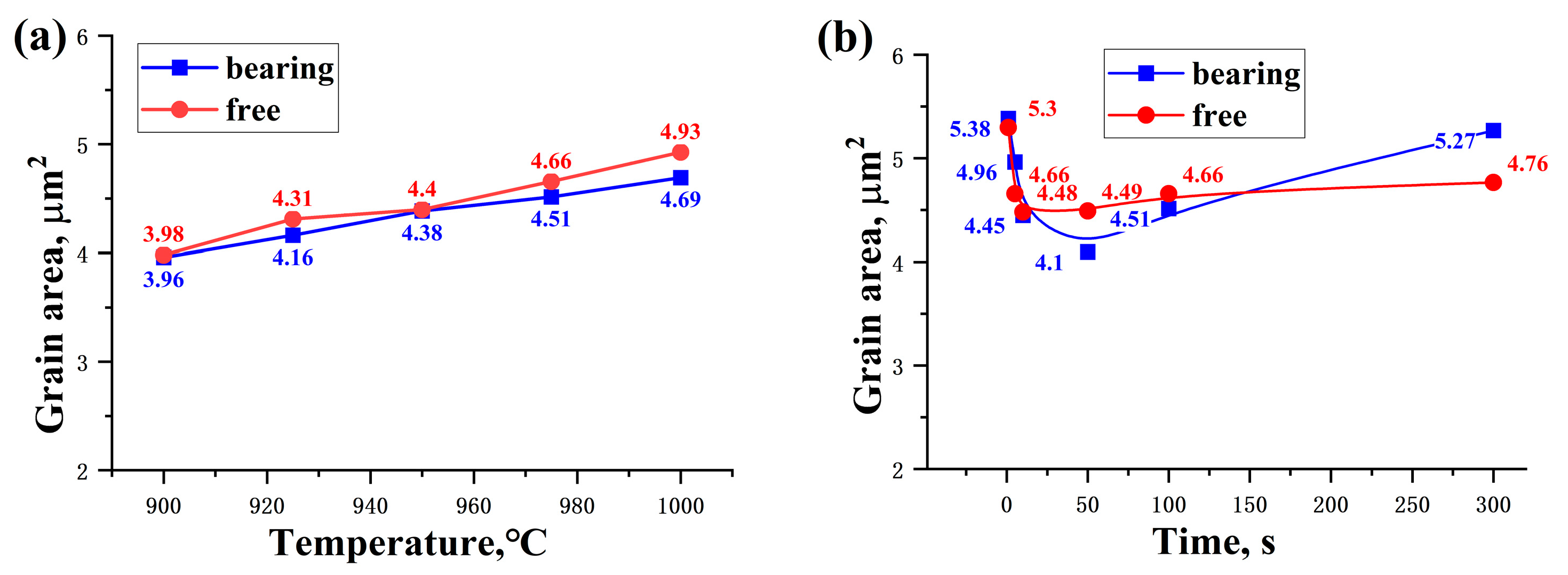
| Samples | C | Si | Mn | Cr | Nb | P + S | Fe | |
|---|---|---|---|---|---|---|---|---|
| 1 | Nb-free | 0.98 | 0.98 | 0.49 | 0.35 | - | <0.003 | Bal |
| 2 | Nb-bearing | 0.98 | 0.99 | 0.48 | 0.35 | 0.025 | <0.003 | Bal |
| Temperature | 900 °C | 925 °C | 950 °C | 975 °C | 1000 °C | ||||||
|---|---|---|---|---|---|---|---|---|---|---|---|
| Time | R/% | XSRX/% | R/% | XSRX/% | R/% | XSRX/% | R/% | XSRX/% | R/% | XSRX/% | |
| 1 | 1 s | 25.34 | 6.68 | 48.46 | 35.57 | 51.07 | 38.86 | 61.53 | 51.91 | 70.38 | 63.00 |
| 5 s | 59.25 | 49.07 | 78.46 | 70.08 | 87.36 | 84.20 | 90.29 | 87.86 | 90.74 | 88.42 | |
| 10 s | 67.26 | 59.08 | 85.17 | 81.46 | 88.60 | 85.57 | 94.82 | 93.52 | 91.75 | 89.69 | |
| 50 s | 74.81 | 68.52 | 88.95 | 86.18 | 90.50 | 88.12 | 95.54 | 94.43 | 94.82 | 93.53 | |
| 100 s | 76.26 | 70.33 | 92.98 | 91.22 | 93.00 | 91.25 | 96.06 | 95.08 | 98.50 | 98.13 | |
| 300 s | 82.28 | 77.86 | 93.46 | 91.83 | 94.03 | 92.54 | 97.49 | 96.86 | 99.67 | 99.59 | |
| 2 | 1 s | 15.86 | -- | 27.51 | 9.39 | 36.73 | 20.91 | 48.55 | 35.69 | 59.55 | 49.43 |
| 5 s | 49.66 | 37.08 | 60.50 | 50.63 | 72.85 | 66.06 | 77.72 | 72.15 | 80.43 | 75.53 | |
| 10 s | 68.87 | 61.09 | 77.90 | 72.38 | 78.30 | 72.88 | 83.76 | 79.67 | 83.36 | 79.20 | |
| 50 s | 77.79 | 72.23 | 81.83 | 77.29 | 83.16 | 78.94 | 84.87 | 80.87 | 85.67 | 82.08 | |
| 100 s | 80.13 | 75.16 | 81.95 | 77.44 | 86.09 | 82.61 | 86.11 | 82.64 | 91.13 | 88.92 | |
| 300 s | 85.13 | 81.41 | 85.51 | 81.89 | 86.67 | 83.34 | 88.63 | 85.78 | 91.66 | 89.57 | |
Disclaimer/Publisher’s Note: The statements, opinions and data contained in all publications are solely those of the individual author(s) and contributor(s) and not of MDPI and/or the editor(s). MDPI and/or the editor(s) disclaim responsibility for any injury to people or property resulting from any ideas, methods, instructions or products referred to in the content. |
© 2024 by the authors. Licensee MDPI, Basel, Switzerland. This article is an open access article distributed under the terms and conditions of the Creative Commons Attribution (CC BY) license (https://creativecommons.org/licenses/by/4.0/).
Share and Cite
Zhou, J.; Yu, Z.; Chen, J.; Wu, S.; Wu, K.; Pan, L. The Performance of Niobium-Microalloying Ultra-High-Strength Bridge Cable Steel during Hot Rolling. Materials 2024, 17, 1259. https://doi.org/10.3390/ma17061259
Zhou J, Yu Z, Chen J, Wu S, Wu K, Pan L. The Performance of Niobium-Microalloying Ultra-High-Strength Bridge Cable Steel during Hot Rolling. Materials. 2024; 17(6):1259. https://doi.org/10.3390/ma17061259
Chicago/Turabian StyleZhou, Jie, Zhichao Yu, Jiahui Chen, Sheng Wu, Kaiming Wu, and Libo Pan. 2024. "The Performance of Niobium-Microalloying Ultra-High-Strength Bridge Cable Steel during Hot Rolling" Materials 17, no. 6: 1259. https://doi.org/10.3390/ma17061259





